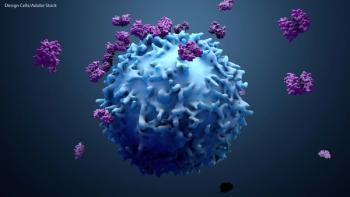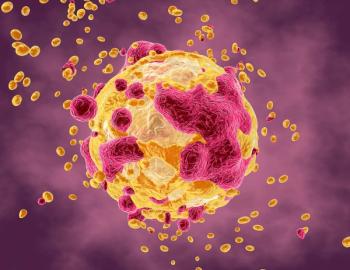
Oncology NEWS International
- Oncology NEWS International Vol 19 No 12
- Volume 19
- Issue 12
Postgastrectomy Patients May Benefit From HP Eradication Rx
After resection for cancer or peptic ulcer disease, the mucosa of the gastric stump is considered prone to the development of gastric cancer precursor lesions (see Fact box), most likely because of exposure to Helicobacter pylori infection. Italian researchers set out to determine if the risk of gastric cancer recurrence was greater in the stump in the presence of HP infection.
Study links gastric remnant cancer and Helicobacter pylori infection.
After resection for cancer or peptic ulcer disease, the mucosa of the gastric stump is considered prone to the development of gastric cancer precursor lesions (see Fact box), most likely because of exposure to Helicobacter pylori infection. Italian researchers set out to determine if the risk of gastric cancer recurrence was greater in the stump in the presence of HP infection.
For this study, Andrea Giuliani, MD, Luigi Basso, MD, and colleagues enrolled 187 patients who had received gastric resection for peptic duodenal ulcer (group 1) or advanced gastric cancer (group 2) and had gastric endoscopy years after the surgery. The investigators are from the department of surgery Pietro Valdoni at the University of Rome La Sapienza and the department of experimental medicine and pathology at the Policlinico Umberto I in Rome.
None of the patients had received eradication therapy for HP infection, antibiotics, nonsteroidal anti-inflammatory drugs, or chemotherapy in the month before gastric endoscopy. Up to a dozen biopsy specimens were routinely taken from the stoma and peristomal areas; from other areas of residual gastric mucosa along the lesser and greater curvatures; and from any areas showing erythema, erosion, or friability, the authors explained (Arch Surg 145:962-967, 2010).
According to the results, gastric cancer precursor lesions (GCPLs) were more common in the entire HP-positive population compared with the HP-negative patients (odds ratio [OR] 2.37, P = .007). In group 2, the HP-positive patients had a higher risk of GCPLs than the HP-negative patients (OR 4.20) and than all of the group 1 patients (OR 1.59).
Group 1 showed a prevalence of intestinal metaplasia, chronic nonatrophic gastritis (NAG), inflammation (P = .003), and HP infection (P = .05). In group 2, there was a prevalence of normal mucosa (P = .02) and dysplasia. The biopsy specimens showed that younger patients had a prevailing incidence of intestinal metaplasia while older patients had dysplasia and NAG (P = .04).
In group 1, a longer postoperative period before endoscopy corresponded to an increased incidence of normal mucosa and dysplasia while a shorter interval was linked to an increased incidence of chronic atrophic gastritis and inflammation. In group 2, a longer postoperative interval was related to multiple symptoms and HP infection. The occurrence of GCPLs was related to longer postoperative intervals, the authors stated.
The group concluded that HP positivity could indicate the expression of persistent or newly developed infection. "The risk of GCPLs, inflammation, and activity in HP-positive patients was notably increased compared with HP-negative patients," they wrote. "This is the most significant finding of our study and proves that there is a link between HP infection and gastric cancer carcinogenesis."
They strongly recommended that postgastrectomy patients undergo HP status assessment and possible HP eradication therapy after gastric resection.
FACT: Stomach cancer precursor
Cancer of the stomach is generally thought to develop from gastric cancer precursor lesions (GCPLs), including chronic atrophic gastritis, intestinal metaplasia, and dysplasia.
VANTAGE POINT
Research must look at mechanics of HP and malignant transformation
The associations between HP and subsequent gastric cancer made in this study are helpful, but the investigative community must dig deeper to identify the mechanism of action that leads to the development of gastric cancer after resection, wrote Dr. Behrns in an accompanying editorial. Dr. Behrns is the chair of the department of surgery at the University of Florida in Gainesville.
“Although the data suggest that patients with HP infection are indeed at risk for the development of premalignant lesions, it is also clearly evident that HP-negative patients were at significant risk for GCPLs,” Dr. Behrns said (Arch Surg 145:967, 2010).
The presence of HP infection does not appear to be solely responsible for the development of gastric cancer; another key element could be chronic inflammation, he said. As a result, “simple treatment for HP infection and/or a surveillance program clearly will not eliminate the development of gastric cancer in the remnant stomach.”
Dr. Behrns stressed that the surgical community must perform more hypothesis-driven, basic science studies in order to better understand the underlying mechanism of HP infection and chronic inflammation in this patient population.
Articles in this issue
almost 15 years ago
Roche Gains OK in Europe for Rituximab for Maintenancealmost 15 years ago
JAK inhibitor quells symptoms linked to myelofibrosisalmost 15 years ago
E-Charts help track course of febrile events in hematologyalmost 15 years ago
Duke Cancer Center Lands Renewal of $30 Million Grantalmost 15 years ago
Even Insured Cancer Patients May Stumble Over Co-pays and Drug Costsalmost 15 years ago
New Jersey cancer center features green lobbyalmost 15 years ago
Growing number of pts undergo radiotherapyNewsletter
Stay up to date on recent advances in the multidisciplinary approach to cancer.



















































































